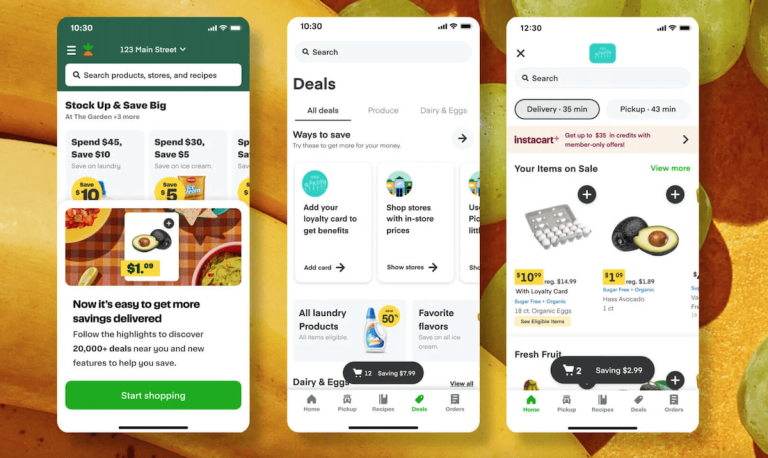Instacart Steps Up Discount Offerings Amid Inflation

As consumers cut grocery spending amid inflation, Instacart is stepping up its savings-oriented offerings.
The grocery aggregator announced Tuesday (April 25) that it was adding more discounting and price-centric features. These include a “Stores to Help You Save” section to help consumers find lower-priced retailers, the ability to apply merchants’ loyalty programs via shoppers’ Instacart accounts, targeted sale offers based on previous purchases, discounts for larger purchases and more.
“We know rising grocery prices won’t go away overnight — so we will continue to introduce new ways to save in the Instacart app over the coming months,” the aggregator stated in a blog post announcing the offers.
The news comes months after Instacart announced the launch of its Promotions suite of advertising offerings for consumer packaged goods (CPG) brands, offering them self-service options to show consumers personalized deals, promotions and coupons amid the increased demand for price-centric marketing initiatives.
Offering these kinds of price-focused promotions can be essential for retailers and aggregators to maintain consumers’ grocery spending, given that high prices can cause shoppers to seek out other options.
In fact, data from PYMNTS’ study “Changes in Grocery Shopping Habits and Perception,” which drew from a December survey of more than 2,400 U.S. consumers, revealed that, among consumers who are purchasing fewer of their day-to-day products at the grocery store, the majority — 54% — cite high prices or lack of benefits or deals as a key factor influencing their decision to cut back.
Plus, PYMNTS’ report “The 2023 Global Digital Shopping Index: U.S. Edition,” which draws from a survey of more than 2,800 U.S. consumers, revealed that 39% of consumers considered coupon usage to be very or extremely important when choosing merchants, and an additional 3% cited this as the single most important concern when deciding where to make purchases.
Consumer Seek Deals
In a recent interview with PYMNTS, Sean Turner, co-founder and CTO at retail technology company Swiftly, spoke to how inflation is prompting consumers to switch merchants.
“Shoppers are clipping more coupons,” Turner said, noting consumers are planning their grocery shopping trips more in advance. “They’re really trying to compare prices across different stores. They might go to the Walmart website or app and see what the product costs there, then launch one of our retailer’s apps like Save Mart’s app or the 99 Cents Only app and search for the same product there to see where it’s cheapest or where they can get a coupon or a discount.”
Grocers are noting the necessity to offer discounts. Research from PYMNTS’ study “Big Retail’s Innovation Mandate: Convenience and Personalization,” created in collaboration with ACI Worldwide, which draws from a survey of 300 U.S. and U.K. retailers, found that 74% of grocers think that consumers would be very or extremely likely to switch merchants if digital coupons and rewards were not provided.
Around the world, grocery giants are looking to find ways to offer the most effective coupons while maintaining their margins, leveraging consumer data to get more efficient in targeting their messaging. Last month, for instance, in a ShopTalk 2023 discussion, Yael Cosset, Kroger’s chief information officer and senior vice president, spoke to the company’s data efforts, noting that the company delivered $1.4 billion in discounts last year.
“Kroger pioneered the personalization approach because we wanted to understand how customers engaged with our offers to make them better and more relevant,” Cosset said. “Our best-in-class data science program creates personalized experiences that provide important savings on the very specific items we know our customers love.”
Similarly, on its earnings call earlier this month, British multinational grocery giant Tesco shared that it offered more than 90 million coupons in the last year, delivering personalized offers to more than 4 million consumers.